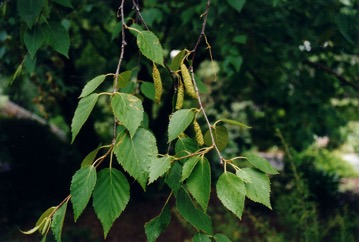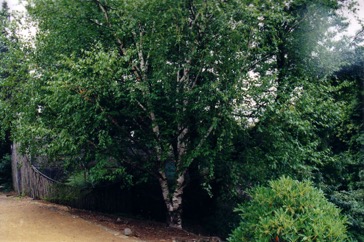Paper birch, Canoe Birch, White birch

It is a temperate plant. It is very cold hardy. It grows on forest edges and lake shores. It will grow on a variety of soils. It cannot tolerate shade. It suits hardiness zones 2-8. Arboretum Tasmania.
Edible Portion
- Flowers, Leaves, Sap, Bark, Leaves - tea
Where does Paper birch grow?
Found in: Alaska, Australia, Canada, Greenland, North America, Tasmania, United States
Notes: There are about 60 Betula species. They grow in cool north temperate climates. The bark has high levels of betulinic acid and may have anti-cancer properties.
Status: Birch syrup is produced commercially in Alaska.
Growing Paper birch, Canoe Birch, White birch
Cultivation: Plants are grown from seed.
Edible Uses: The very young leaves, shoots and catkins can be eaten in salads or stir-fried dishes. The sap is used for a drink and can be boiled down to syrup or sugar. It can be used to make birch beer or vinegar. Birch syrup is used for ice cream, pancakes and in cocoa and coffee drinks. The young leaves are used for tea.
Production: Trees live for 120 years. Sap flow is best on sunny days after a frost.
Nutrition Info
per 100g edible portion| Edible Part | Energy (kcal) | Protein (g) | Iron (mg) | Vitamin A (ug) | Vitamin c (mg) | Zinc (mg) | % Water |
|---|---|---|---|---|---|---|---|
| Flowers | - | - | - | - | - | - | |
| Leaves | - | - | - | - | - | - | |
| Sap | - | - | - | - | - | - | |
| Bark | - | - | - | - | - | - | |
| Leaves - tea | - | - | - | - | - | - |
Paper birch, Canoe Birch, White birch Photos


References
Arbust. amer. 19. 1785
Bircher, A. G. & Bircher, W. H., 2000, Encyclopedia of Fruit Trees and Edible Flowering Plants in Egypt and the Subtropics. AUC Press. p 59
Bodkin, F., 1991, Encyclopedia Botanica. Cornstalk publishing, p 145
Bowser, M., 2017, Handout on Edible Plants of the Kenai Peninsula. USFWS Kenai National Wildlife Refuge p 10
Coombes, A.J., 2000, Trees. Dorling Kindersley Handbooks. p 123
Cundall, P., (ed.), 2004, Gardening Australia: flora: the gardener's bible. ABC Books. p 236
Etkin, N.L. (Ed.), 1994, Eating on the Wild Side, Univ. of Arizona. p 69
Hibbert, M., 2002, The Aussie Plant Finder 2002, Florilegium. p 43
Facciola, S., 1998, Cornucopia 2: a Source Book of Edible Plants. Kampong Publications, p 49
Farrar, J.L., 1995, Trees of the Northern United States and Canada. Iowa State University press/Ames p 284
Grandtner, M. M., 2008, World Dictionary of Trees. Wood and Forest Science Department. Laval University, Quebec, Qc Canada. (Internet database http://www.WDT.QC.ca)
http://en.hortipedia.com
Little, E.L., 1980, National Audubon Society Field Guide to North American Trees. Alfred A. Knopf. p 368
Lord, E.E., & Willis, J.H., 1999, Shrubs and Trees for Australian gardens. Lothian. p 48
Lyle, S., 2006, Discovering fruit and nuts. Land Links. p 93
MacKinnon, A., et al, 2009, Edible & Medicinal Plants of Canada. Lone Pine. p 53
Plants for a Future database, The Field, Penpol, Lostwithiel, Cornwall, PL22 0NG, UK. http://www.scs.leeds.ac.uk/pfaf/
Young, J., (Ed.), 2001, Botanica's Pocket Trees and Shrubs. Random House. p 138